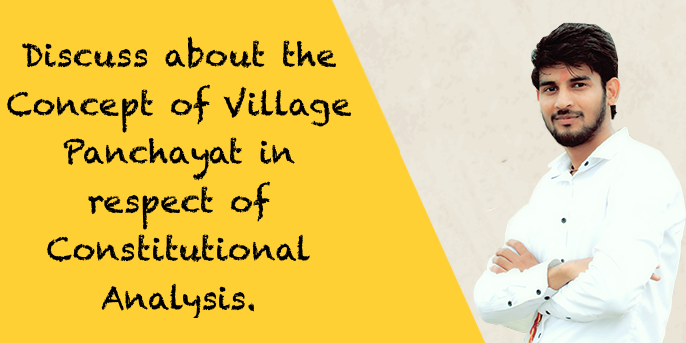Discuss about the Concept of Village Panchayat in respect of Constitutional Analysis.
Ans. It is the oldest system of local government in the Indian subcontinent. The word “panchayat” literally means “assembly” (ayat) of five (panch) wise and respected elders chosen and accepted by the local community.[i]Traditionally, these assemblies settled disputes between individuals and villages.British established local self-government in 1869 when they made a District Local Fund in Bombay. This was a nominated body.ln 1882, Lord Ripon established local self- government in India with the seating up of district local boards. District boards and councils were established in Maratheada and vidarbh. The next important piece of legislation was the Bombay village panchyat Act 1920. Under this Act, the Panchayats was constituted into an elected body. Members were elected by adult male villagers and the Panchayat was entrusted with local functions, mainly of a civil nature. Panchayat were empowered to collect compulsory house taxes.The Bombay Village Panchayat Act 1920 empowered village Panchayats to take up various activities, including some social-economic functions, and gave the power to heavy taxes and duties in order to increase their income. After the reorganisation of states in 1956, laws to introduce the Panchayat system in different stator were gradually enacted. This process was almost complete in Andhra Pradesh, Assam, Madhya Pradesh, Madras, Mysore, Orissa, Punjab, Rajasthan, Utter Pradesh and Bombay.[ii]The Bombay Village Panchyats Act was enacted in Producers for seeking legal redress through judicial courts are both long and enormously complicated, and also involve considerable expenses. It is because of this that several different and newer ways of setting disputes both quickly and inexpensively have come up. One such method is the LokAdalat 1958. Under the Act, a district village for the supervision and control of village Panchayats.[iii] These Mandals were, however, abolished in 1962.Apart from this enactment in various states, a direction is contained in the Constitution of India inArticle 40 which says that “The State shall take steps to organize village Panchyats and endow them with such powers and authority as may be necessary to enable them to function as units of self-government. [ iv] Under the new enactment, a Gram Sabha of adult residents in the village was constituted, and it was made obligatory on the Panchayats to hold meetings of the Gram Sabha within two months from the commencement of every financial year and to prepare an annual statement of accounts to be placed before such a meeting. The administrative report, the proposed development programmes, adult report, compliance of adult objections and other such matters were also required to be placed before this meeting. Group NyayaPanchyats were established, but later they were abolished. Obligatory duties of the Panchayats were mainly of a civil nature that is, making provisions for sanitation, street lights and drinking water. The discretionary functions covered the fields of agriculture, cooperation, animal husbandry, self-defence and other such administrative and development works. Village Panchayats are controlled and supervised by ZillaParishads, PanchayatSamitis and their officers. The state government also has direct control over Panchayats through the Collector of the district. District Village Panchayat officers work under ZillaParishads to supervise and control the village Panchayats, and are appointed by the state governments.There is however, no proper machinery for the public to air their grievances and control malpractice in ZillaParishads. Vested interests in the government have always been found to be sheltering corrupt elements in the system and they are now well entrenched.Government control over this institution has seldom proved to be effective and the poor masses at the grassroots level are yet to get benefit from the existing system of Panchyati Raj.ln view of these shortcomings, part IX, consisting of Article 243 to 243 was inserted by the Constitution (73 rd Amendment) Act, 1992.








